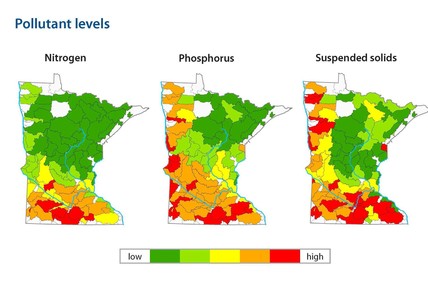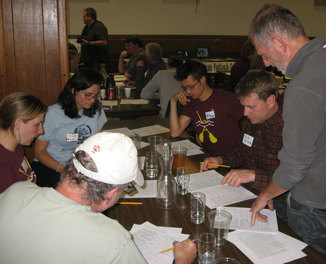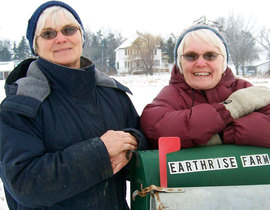April 2015
 Poor water quality in
southern Minnesota waters is a reflection of agriculture dominating their
surrounding landscape. In heavily farmed areas, the lakes and streams tend to
have high levels of nitrogen, phosphorus and sediment that hurt aquatic life
and recreational opportunities, according to a report released April 29 by the
Minnesota Pollution Control Agency (MPCA). Urban areas also suffer some
water pollution, but their acreage is far less than agricultural land in
Minnesota.
While watershed
professionals
have long had a general sense of the problems facing our waters, they now have
a much better understanding of the scale and sources. This supports creating
better strategies for addressing the problems and getting more citizen
involvement. Many citizen groups have formed in recent years to focus on
their respective watersheds, and there are many examples of efforts by
agriculture to address water quality problems.
The report highlights important points for
citizens, landowners and decision-makers:
- In
watersheds dominated by agricultural and urban land, half or less of the
lakes fully support the standard for swimming.
- In
areas with a high density of people and livestock – the developed and
agricultural portions of the state -- less than half of the streams tend
to fully support swimming because of bacteria levels.
- Generally
speaking, water quality is exceptionally good in the northeast part
of the state and worsens moving toward the southwest.
The MPCA and partners have identified these
stressors to water quality throughout Minnesota:
- Low
dissolved oxygen levels that make it hard to sustain fish and other
aquatic life.
- Excess
nutrients that cause algal blooms and other problems.
- Excess
sediment that makes the water murky.
- Altered
hydrology from streams and land being changed to facilitate drainage.
- Lack
of habitat to sustain fish and other aquatic life.
- Lack
of connectivity, meaning obstacles like dams block the migration of fish.
In looking at stressors by region, the
southern region of Minnesota has the highest numbers of stressors related to
excess nutrients and sediment, lack of habitat and connectivity, altered
hydrology, and impaired communities of fish and bugs.
After identifying stressors and healthy
conditions, the MPCA and partners develop strategies to restore and protect
waters:
- Common
strategies include stream buffers, nutrient and manure management,
stormwater controls, and in-lake treatments.
- While
most strategies are tailored for their watersheds, some strategies do call
for stronger and more targeted application of state and local laws on
feedlots, shoreland, septic systems, stormwater controls, and wastewater
discharges.
To view the full report, “Swimmable, Fishable,
Fixable?” visit the MPCA website at www.pca.state.mn.us.
Back to top
|
The Environmental Quality Board and the Department of Employment and Economic
Development are working on a water report including
results of a survey of water-related organizations in Minnesota. The survey results will help develop an
economic profile that quantifies the current employment and wages in
water-related organizations. The survey will go to public and private sector
entities involved in the research, development, treatment,
manufacture, assembly, installation, management, sales, support or distribution
of water products or services. Link to survey.
The goal is to understand their present
employment, revenue, and products in the sector. This will be combined with
administrative datasets to build a profile of water employment and wages in the
state. It follows a method laid out by MN Clean Energy Economy Profile. For more information, contact Anna Sherman, anna.sherman@state.mn.us., 651-259-7468, Dept.
of Employment and Economic Development, 1st
National Bank Building, 332 Minnesota St., Suite E-200, St. Paul.
Back to top
 Progress toward a basin-wide organization for the Minnesota
River took another step forward at the third Minnesota River Congress April 16
at New Ulm. The work will resume at a fourth congress July 23. More than 80 people voted on a mission statement, governing board structure, and ranked statements of purpose. Mission statement: Promote citizen participation from all communities of interest and take cooperative action to protect, conserve, and improve the Minnesota River system.
The
organizing team will evaluate and further refine the results. A proposed organizational
chart and a descriptive document will be brought to the 4th Minnesota River
Congress July 23 for further review, discussion and potential adoption. “It was a clear success, and a huge ‘thank you’ goes out to sponsors, networking fair participants, organizing team, and all who came in person,” says Scott Sparlin of Coalition for a Clean Minnesota River.
The congress is open to everyone interested in the economic, social, and
natural resource vitality of the basin, encompassing nearly 11 million acres,
more than 700,000 people, and thousands of farms and industries. Organizers believe there’s a
need for a citizen-led entity that is inviting and all inclusive for the many
different groups active in the Minnesota River Valley, including agriculture,
industry, natural resources, recreation, economic development, tourism, all
levels of government, faith communities, first nations, and watershed
organizations. For more information, contact Scott Sparlin, 507-276-2280, yasure@lycos.com; or
Ted Suss, (507)
828-3377, tedsuss@gmail.com.
Back to top
|
 The 12th Watershed
Network meeting April 23 in Redwood Falls provided learning and networking for 28 people from agencies, watershed organizations, and industry. Christine
Yaeger of the Dept. of Agriculture introduced the Minnesota
Water Research Digital Library. It is now available online to assist water
research, share publications, and coordinate with water researchers. Beth
Knudsen and Jon Lore of the Dept. of Natural Resources, presented the Watershed Health Assessment
Framework, and High Island Creek projects, respectively.
Shawn Wohnoutka of
Redwood-Cottonwood Rivers Control Area presented on Farmer Perspectives on
Climate Variability, Scott Sparlin gave an update on progress of the Minnesota
River Congress, and Forrest Peterson introduced a ‘Perspective on science –
physical and social – for water quality’. Slides from the topics will be
available on the Watershed Network webpage in the near future. The fall
Watershed Network meeting is tentatively scheduled for Nov. 19 in New Ulm. Photo (from left): Paul Meints, Minnesota Corn Growers Association; Skip Wright, DNR; Jan Voit (seated) Heron Lake Watershed District; Barb Huberty, Legislative Water Commission; Jon Lore, DNR.
Back to top
|
 This year’s RiverKeeper award presented by Clean Up the
River Environment went to Kay and Annette Fernholz. They were honored at CURE’s
annual meeting with 150 people attending April 18 in Maynard. First awarded in
1994, the RiverKeeper goes to an individual(s), organization or government
agency who has worked in an exemplary manner to carry out CURE’s mission “to
focus public awareness on the Minnesota River Basin and to take action to
restore and protect its water quality, biological integrity, and natural beauty
for all generations.” The sisters grew up on the family farm near Madison, and
both became Sisters of Notre Dam. As educators on their EarthRise Farm in Lac
qui Parle County, Kay and Annette have connected hundreds of people to a story
of caring for the land and creation stewardship.
With the theme, Growing Clean Water: Connecting Agriculture and
Stewardship, the annual meeting day started with a presentation and roundtable
discussion of redesigning farming and embracing sustainable approaches
to food production, while still reaping real profits. CURE selected Gov. Mark
Dayton for the Good Government Award because of his commitment to advance clean
water goals, primarily through his steadfast support for the Buffer Initiative. Other award recipients
included Lauri Wyum of Montevideo, recognized as CURE Volunteer of the Year.
Ken Paulman of Fresh Energy received CURE’s Good Media Award for his work
publishing Midwest Energy News.
And Sally Finzel of Morning Sky Greenery, a nursery
specializing in Minnesota native prairie wildflowers and grasses, accepted the
Good Business Award. - Information from CURE website.
Back to top
|
 Registration is open for the Gulf of
Mexico Hypoxia Task Force public meeting and webcast, 12:30-4 p.m.
Wednesday, May 20, at the Crowne Plaza hotel in Columbus Ohio. The program
includes updates from USDA on the Mississippi River Basin Initiative and
Regional Conservation Partnership Program, a nutrient stewardship panel, and
activity reports from partner organizations. The task force was established in 1997 to understand the causes and effects
of eutrophication in the Gulf of Mexico; coordinate activities to reduce the
size, severity, and duration; and ameliorate the effects of hypoxia. Visit https://water-meetings.tetratech.com/Hypoxia/StaticPublic/index.htm to register, find meeting and location
information, and download the meeting agenda and other materials (registration
is free). If you have any questions about the meeting, contact: Kimberlyn
Velasquez at Velasquez.Kimberlyn@epa.gov, or Hazel Groman at Groman.Hazel@epa.gov.
Back to top
|
|